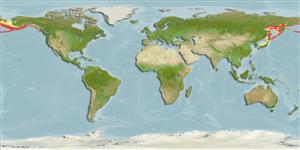Malacostraca |
Decapoda |
Lithodidae | Lithodinae
Environment: milieu / climate zone / djupintervall / distribution range
Ekologi
; djupintervall 25 - 489 m (Ref. 101157). Temperate, preferred 4°C (Ref. 107945); 66°N - 36°N, 131°E - 132°W
Northern Pacific and the Arctic: Alaska, Russia and Japan. Temperate to polar.
Length at first maturity / Size / Weight / Age
Könsmognad: Lm ? range ? - ? cm Max length : 22.0 cm CW hane/ej könsbestämd; (Ref. 110584); 16 cm CW (female); publicerad maxvikt: 4.5 kg (Ref. 110584); publicerad maxvikt: 4.5 kg
Prefers disparate, deep habitats with cobble, gravel, and rock (Ref. 110607). Exhibits cannibalism (Ref. 101157).
Life cycle: The species undergoes four zoeal stages, molts into glaucothoe stage then to juvenile stage, and matures into adult stage. Mating behavior: Biennial reproduction, mating occurs in shallow waters (Ref. 110566). Precopulatory courtship ritual is common (through olfactory and tactile cues); usually indirect sperm transfer (Ref. 833).
Bisby, F.A., M.A. Ruggiero, K.L. Wilson, M. Cachuela-Palacio, S.W. Kimani, Y.R. Roskov, A. Soulier-Perkins and J. van Hertum 2005 Species 2000 & ITIS Catalogue of Life: 2005 Annual Checklist. CD-ROM; Species 2000: Reading, U.K. (Ref. 19)
IUCN Red List Status
(Ref. 130435: Version 2025-1)
CITES status (Ref. 108899)
Not Evaluated
Not Evaluated
Threat to humans
Human uses
Fiskeri: kommersiell
FAO - fiskeri: landings | FishSource | Sea Around Us
Verktyg
Ytterligare information
PhysiologySyreförbrukning
Human RelatedStamps, coins, misc.
Internet-källor
Estimates based on models
Preferred temperature
(Ref.
115969): 1 - 12.2, mean 3.5 (based on 64 cells).
Fishing Vulnerability
Low vulnerability (12 of 100).
Climate Vulnerability
High to very high vulnerability (74 of 100).
Nutrients : Calcium = 109 [35, 184] mg/100g; Iron = 1.59 [1.21, 1.97] mg/100g; Protein = 20.2 [19.2, 21.3] %; Omega3 = 0.285 [0.185, 0.386] g/100g; Selenium = 48.3 [-31.7, 128.3] μg/100g; VitaminA = 0 μg/100g; Zinc = 1.79 [1.17, 2.40] mg/100g (wet weight); based on
nutrient studies.
